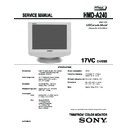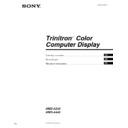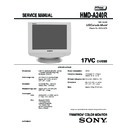Sony HMD-A240 Service Manual ▷ View online
8
Si aparecen líneas finas en pantalla
(hilos de amortiguación)
Estas líneas no indican falla de funcionamiento; son un efecto
normal del tubo de imagen Trinitron con este monitor. Se trata de
sombras de los hilos de amortiguación utilizados para estabilizar la
rejilla de apertura. La rejilla de apertura es el elemento esencial que
hace que el tubo de imagen Trinitron sea único al permitir que llegue
más luz a la pantalla, obteniéndose imágenes con mayor brillo y
detalle.
normal del tubo de imagen Trinitron con este monitor. Se trata de
sombras de los hilos de amortiguación utilizados para estabilizar la
rejilla de apertura. La rejilla de apertura es el elemento esencial que
hace que el tubo de imagen Trinitron sea único al permitir que llegue
más luz a la pantalla, obteniéndose imágenes con mayor brillo y
detalle.
Función de autodiagnóstico
Este monitor dispone de una función de autodiagnóstico. Si existe un
problema con su monitor o con su computadora, la pantalla se
quedará sin imagen y el indicador 1 (alimentación) se iluminará en
verde o parpadeará en naranja. Si el indicador 1 (alimentación) se
ilumina en naranja, significa que la computadora está en el modo de
ahorro de energía. Oprima cualquier tecla del teclado o mueva el
ratón.
problema con su monitor o con su computadora, la pantalla se
quedará sin imagen y el indicador 1 (alimentación) se iluminará en
verde o parpadeará en naranja. Si el indicador 1 (alimentación) se
ilumina en naranja, significa que la computadora está en el modo de
ahorro de energía. Oprima cualquier tecla del teclado o mueva el
ratón.
x Si el indicador 1 (alimentación) se ilumina en verde
1
Desconecte el cable de entrada de vídeo o apague la
computadora conectado.
computadora conectado.
2
Oprima el botón 1 (alimentación) dos veces para apagar
el monitor y volver a encenderlo.
el monitor y volver a encenderlo.
3
Mueva el botón de control
, durante 2 segundos.
Si aparecen cuatro barras de color (blanco, rojo, verde, azul), significa
que el monitor funciona correctamente. Vuelva a conectar los cables
de entrada de vídeo. Ajuste el brillo y el contraste y pruebe el monitor.
Si el problema persiste, examine la computadora.
Si las barras de color no aparecen, significa que existe una posibilidad
de falla del monitor. Informe a un proveedor Sony autorizado sobre el
estado del monitor.
que el monitor funciona correctamente. Vuelva a conectar los cables
de entrada de vídeo. Ajuste el brillo y el contraste y pruebe el monitor.
Si el problema persiste, examine la computadora.
Si las barras de color no aparecen, significa que existe una posibilidad
de falla del monitor. Informe a un proveedor Sony autorizado sobre el
estado del monitor.
x Si el indicador 1 (alimentación) parpadea en
naranja
Apague (OFF) el monitor y vuelva a encenderlo (ON).
Si el indicador 1 (alimentación) se ilumina en verde, significa que el
monitor funciona correctamente.
Si el indicador 1 (alimentación) aún parpadea, significa que existe
una posibilidad de falla del monitor. Cuente el número de segundos
entre los parpadeos en naranja del indicador 1 (alimentación) e
informe a un proveedor Sony autorizado sobre el estado del monitor.
Asegúrese de anotar el nombre del modelo y el número de serie del
monitor. Tome nota también del fabricante y modelo de la
computadora y de la tarjeta gráfica.
monitor funciona correctamente.
Si el indicador 1 (alimentación) aún parpadea, significa que existe
una posibilidad de falla del monitor. Cuente el número de segundos
entre los parpadeos en naranja del indicador 1 (alimentación) e
informe a un proveedor Sony autorizado sobre el estado del monitor.
Asegúrese de anotar el nombre del modelo y el número de serie del
monitor. Tome nota también del fabricante y modelo de la
computadora y de la tarjeta gráfica.
Especificaciones
HMD-A240
TRC
TRC
Paso de la rejilla de apertura de
0,24 mm (centro)
17 pulgadas, medido en diagonal
90 grados de deflexión
FD Trinitron
0,24 mm (centro)
17 pulgadas, medido en diagonal
90 grados de deflexión
FD Trinitron
Tamaño de imagen visible
Aprox. 327
× 243 mm (an/al)
(12
7
/8
× 9
5
/8 pulgadas)
Imagen visible
Aprox. 406 mm (16 pulgadas)
Resolución
Máxima
Horizontal: 1280 puntos
Vertical: 1024 líneas
Vertical: 1024 líneas
Recomendada Horizontal: 1024 puntos
Vertical: 768 líneas
Área de imagen estándar
Aprox. 312
× 234 mm (an/al)
(12
3
/8
× 9
1
/4 pulgadas)
Frecuencia de deflexión
Horizontal: 30 a 70 kHz
Vertical: 48 a 120 Hz
Vertical: 48 a 120 Hz
Corriente/tensión de entrada de ca
100 - 120 V, 50 - 60 Hz, Máx. 1,7 A
Consumo de energía
Aprox. 100 W
Temperatura de funcionamiento
10 ºC a 40 ºC
Dimensiones
Aprox. 422
× 432 × 426 mm (an/al/prf)
(16
5
/8
× 17
1
/8
× 16
1
/2 pulgadas)
Peso
Aprox. 18 kg (39,1 lb)
Plug and Play
DDC2B/DDC2Bi
GTF
GTF
Accesorios suministrados
Cable de alimentación (1)
Tarjeta de garantía (1)
Este manual de instrucciones
Tarjeta de garantía (1)
Este manual de instrucciones
HMD-A440
TRC
TRC
Paso de la rejilla de apertura de
0,24 mm (centro)
19 pulgadas, medido en diagonal
90 grados de deflexión
FD Trinitron
0,24 mm (centro)
19 pulgadas, medido en diagonal
90 grados de deflexión
FD Trinitron
Tamaño de imagen visible
Aprox. 365
× 274 mm (an/al)
(14
3
/8
× 10
7
/8 pulgadas)
Imagen visible
Aprox. 456 mm (18 pulgadas)
Resolución
Máxima
Horizontal: 1920 puntos
Vertical: 1440 líneas
Vertical: 1440 líneas
Recomendada Horizontal: 1280 puntos
Vertical: 1024 líneas
Área de imagen estándar
Aprox. 352
× 264 mm (an/al)
(13
7
/8
× 10
3
/8 pulgadas)
Frecuencia de deflexión
Horizontal: 30 a 96 kHz
Vertical: 48 a 170 Hz
Vertical: 48 a 170 Hz
Corriente/tensión de entrada de ca
100 - 120 V, 50 - 60 Hz, Máx. 2,0A
Consumo de energía
Aprox. 130 W
Temperatura de funcionamiento
10 ºC a 40 ºC
Dimensiones
Aprox. 461
× 479 × 471 mm (an/al/prf)
(18
1
/8
× 19
1
/8
× 18
1
/2 pulgadas)
Peso
Aprox. 26 kg (57 lb)
Plug and Play
DDC2B/DDC2Bi
GTF
GTF
Accesorios suministrados
Cable de alimentación (1)
Tarjeta de garantía (1)
Este manual de instrucciones
Tarjeta de garantía (1)
Este manual de instrucciones
* Condición de sincronización horizontal y vertical recomendada
• La anchura de sincronización horizontal debe ser superior a 1,0 µseg.
• La anchura de supresión horizontal debe ser superior a 3,0 µseg.
• La anchura de supresión vertical debe ser superior a 500 µseg.
• La anchura de supresión horizontal debe ser superior a 3,0 µseg.
• La anchura de supresión vertical debe ser superior a 500 µseg.
El diseño y las especificaciones están sujetos a cambios sin previo aviso.
Hilos de
amortiguación
amortiguación
i
Appendix
Preset mode timing table
(For HMD-A240)
Preset mode timing table
(For HMD-A440)
If the input signal does not match one of the factory preset modes
above, the Generalized Timing Formula feature of this monitor
will automatically provide an optimal image for the screen as long
as the signal is GTF compliant.
above, the Generalized Timing Formula feature of this monitor
will automatically provide an optimal image for the screen as long
as the signal is GTF compliant.
No. Resolution
(dots
× lines)
Horizontal
Frequency
Frequency
Vertical
Frequency
Frequency
Graphics
Mode
Mode
1
640
× 480
31.5 kHz
60 Hz
VGA-G
2
720
× 400
31.5 kHz
70 Hz
VGA-Text
3
800
× 600
37.9 kHz
75 Hz
VESA
4
800
× 600
53.7 kHz
85 Hz
VESA
5
832
× 624
49.7 kHz
75 Hz
Macintosh 16"
Color
Color
6
1024
× 768
60.0 kHz
75 Hz
VESA
7
1024
× 768
68.7 kHz
85 Hz
VESA
8
1280
× 1024
64.0 kHz
60 Hz
VESA
No. Resolution
(dots
× lines)
Horizontal
Frequency
Frequency
Vertical
Frequency
Frequency
Graphics
Mode
Mode
1
640
× 480
31.5 kHz
60 Hz
VGA-G
2
640
× 480
43.3 kHz
85 Hz
VESA
3
720
× 400
31.5 kHz
70 Hz
VGA-Text
4
800
× 600
53.7 kHz
85 Hz
VESA
5
832
× 624
49.7 kHz
75 Hz
Macintosh 16"
Color
Color
6
1152
× 870
68.7 kHz
75 Hz
Macintosh 21"
Color
Color
7
1024
× 768
68.7 kHz
85 Hz
VESA
8
1280
× 1024
91.1 kHz
85 Hz
VESA
9
1600
× 1200
93.8 kHz
75 Hz
VESA
PRINTING THE SERVICE MANUAL
The PDF of this service manual is not designed to be printed from cover to cover. The pages vary in size, and must therefore be printed in sections
based on page dimensions.
based on page dimensions.
NON-SCHEMATIC PAGES
Data that does NOT INCLUDE schematic diagrams are formatted to 8.5 x 11 inches and can be printed on standard letter-size and/or A4-sized paper.
SCHEMATIC DIAGRAMS
The schematic diagram pages are provided in two ways, full size and tiled. The full-sized schematic diagrams are formatted on paper sizes between
8.5” x 11” and 18” x 30” depending upon each individual diagram size. Those diagrams that are LARGER than 11” x 17” in full-size mode have been
tiled for your convience and can be printed on standard 11” x 17” (tabloid-size) paper, and reassembled.
8.5” x 11” and 18” x 30” depending upon each individual diagram size. Those diagrams that are LARGER than 11” x 17” in full-size mode have been
tiled for your convience and can be printed on standard 11” x 17” (tabloid-size) paper, and reassembled.
TO PRINT
FULL SIZE
SCHEMATIC DIAGRAMS
If you have access to a large paper plotter or printer capable of outputting the full-sized diagrams, output as follows:
1) Note the page size(s) of the schematics you want to output as indicated in the middle window at the bottom of the viewing screen.
2) Go to the File menu and select Print Set-up. Choose the printer name and driver for your large format printer. Con fi rm that the printer settings
are set to output the indicated page size or larger.
3) Close the Print Set Up screen and return to the File menu. Select “Print...” Input the page number of the schematic(s) you want to print in the
print range window. Choose OK.
TO PRINT
TILED VERSIO
N OF SCHEMATICS
Schematic pages that are larger than 11” x 17” full-size are provided in a 11” x 17” printable tiled format near the end of the document. These can be
printed to tabloid-sized paper and assembled to full-size for easy viewing.
printed to tabloid-sized paper and assembled to full-size for easy viewing.
If you have access to a printer capable of outputting the tabloid size (11” x 17”) paper, then output the tiled version of the diagram as follows:
1) Note the page number(s) of the schematics you want to output as indicated in the middle window at the bottom of the viewing screen.
2) Go to the File menu and select Print Set-up. Choose the printer name and driver for your printer. Con fi rm that the plotter settings are set to output
11” x 17”, or tabloid size paper in landscape (
) mode.
3) Close the Print Set Up screen and return to the File menu. Select “Print...” Input the page number of the schematic(s) you want to print in the
print range window. Choose OK.
TO PRINT
SPECIFIC SECTIONS
OF A SCHEMATIC
To print just a particular section of a PDF, rather than a full page, access the Graphics Select tool in the Acrobat Reader tool bar.
1) To view the Graphics Select Tool, press and HOLD the mouse button over the Text Select Tool which looks like:
This tool will expand to reveal to additional tools.
Choose the Graphics Select tool by placing the cursor over the button on of the far right that looks like:
Choose the Graphics Select tool by placing the cursor over the button on of the far right that looks like:
2) After selecting the Graphics Select Tool, place your cursor in the document window and the cursor will change to a plus (+) symbol. Click and
drag the cursor over the area you want to print. When you release the mouse button, a marquee (or dotted lined box) will be displayed outlining
the area you selected.
the area you selected.
3) With the marquee in place, go to the fi le menu and select the “Print...” option. When the print window appears, choose the option under the section
called “Print Range” which says “Selected Graphic”.
Select OK and the output will print only the area that you outlined with the marquee.
(continued
>)
T
ON-SCREEN SEARCH OPTION
All of the text within the service manual PDF is content searchable. This means that you can enter any text, word, phrase or reference number that
appears in the manual, and the PDF software will search, fi nd and move the cursor to the location where you requested text fi rst appears. This feature
can be particularly useful in locating components on a specifi c schematic or printed wire circuit board (PWB) diagrams.
appears in the manual, and the PDF software will search, fi nd and move the cursor to the location where you requested text fi rst appears. This feature
can be particularly useful in locating components on a specifi c schematic or printed wire circuit board (PWB) diagrams.
Follow these steps to effectively locate a component on a schematic diagram:
1) Locate the schematic you want to search by clicking on the corresponding bookmark on the left side of the screen. The view on the right of the
screen will then jump to the desired schematic page.
2) Magnify the diagram to at least 400% before conducting a component search. This will enable you to easily view the reference number when
it is highlighted on screen. To do this, click on the magnifying glass button on the tool bar at the top of the screen. Move the cursor over the
diagram and RIGHT click you mouse. Select the 400% magnifi cation option on the pop-up menu. Click on the button with the icon of the open
hand to deactivate the magnifi cation tool
diagram and RIGHT click you mouse. Select the 400% magnifi cation option on the pop-up menu. Click on the button with the icon of the open
hand to deactivate the magnifi cation tool
3) Search the diagram (or the entire manual) by clicking on the binocular button tool at the top of the screen. The “Find” window will appear and
allow you to type in your desired text. Type in a reference designator, such as R502, and click on the “Find” button. If the component is not on the
diagram, but is listed anywhere else in the manual, the cursor will jump to the fi rst location the text is found in the fi le. To fi nd another instance of
that same text, click on the binocular button again and select “Find Again.”
diagram, but is listed anywhere else in the manual, the cursor will jump to the fi rst location the text is found in the fi le. To fi nd another instance of
that same text, click on the binocular button again and select “Find Again.”



